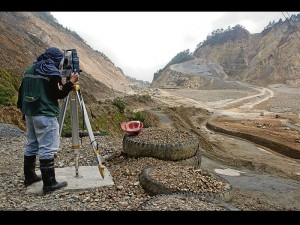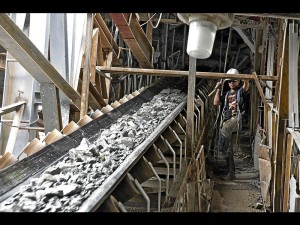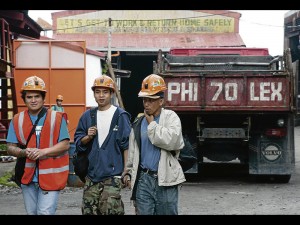One of Philippines’ original mines reflects on new life

A MINER monitors quarrying operations at Philex’s old open pit mine in Benguet. Officials say the site will soon be planted with trees when their operations cease. PHOTO BY ELMER KRISTIAN DAUIGOY/INQUIRER NORTHERN LUZON
BAGUIO CITY – This was supposed to be the year when one of the country’s oldest mines in Benguet should have stopped operations.
In 2006, Philex Mining Corp. put together a closure program that would shut down in five years its Padcal mine in Benguet after 56 years of operations.
Philex is arguably the only old mine to contemplate closure, according to Clarence Baguilat, Cordillera director of the Department of Environment and Natural Resources.
Its program has become a template for other mines because it was designed to clean up the environment and provide livelihood to the mining community Philex would leave behind.
Libby Ricaforte, the company’s Padcal assistant general manager, says an integrated mine closure plan is prescribed by the Philippine Mining Act of 1995 (Republic Act No. 7942), but its own initiative was received well by the local community and industry critics.
Article continues after this advertisementBenguet has been host to many of the country’s old mines for over a century since 1903. Benguet Corp. was the first mining outfit that operated during the American colonial period.
Article continues after this advertisementDowngradedPhilex is the only high-profit mine to concede that it has exhausted its mineral reserve at Padcal down to its low-grade ore body, according to documents supplied by the Mines and Geosciences Bureau. Its been developing the Silangan mine project in Surigao del Norte to take its place.
Mine officials, like geologist Redempta Baluda, now Philex vice president for explorations, have consulted local residents about the company’s likely exit, asking them for ideas as to how it could help build a post-mine community for over 14,000 people who now make up the village surrounding Padcal mine.
Ricaforte says the consultation results guided Philex in designing a livelihood training program, which would be integrated to a company-supported marketing network to help the community develop its economy.
Training plan

A CONVEYOR belt delivers ore at Philex’s milling station. PHOTO BY ELMER KRISTIAN DAUIGOY/INQUIRER NORTHERN LUZON
The training plan was based on four banner enterprises which the community desired: Coffee growing, vegetable cultivation, livestock raising, and meat processing.
A parallel program that would rehabilitate the mine area and develop a forest there had been enforced, Ricaforte says.
But Padcal’s life has been extended to 2017, thanks to the Beijing Olympics in 2008, he says.
Chinese companies, he says, started buying up huge supplies of metals as the Chinese government built sports facilities for the games.
Ricaforte says China’s demand resulted in the increase in world metals prices. On June 27, for example, a troy ounce of gold sold for $1,496.40 (P64,973.68) in the world market.
Reevaluation
“A consequence of the record high prices is that some of what used to be less than economic resources may now be considered ore. Our technical staff in Padcal is now reevaluating the present mineral resources to see if more of it could be classified as ore reserves, and justify the investment in the development work needed to extend the mine life beyond 2017,” says Jose Ernesto Villaluna Jr., Philex president, in a message he gave to the company’s stockholders recently.
Ricaforte says old mines such as Atlas Consolidated Mining and Development Corp., which was started in 1935, had reopened to take advantage of the healthy metals trade.
In his report to stockholders, Manuel Pangilinan, Philex chair and chief executive officer, says the firm’s gold profits, “comprising 54 percent of total revenue, rose to P7.2 billion [in 2010] from P5.1 billion in 2009 and P5.4 billion in 2008.”
“Copper revenue, accounting for 43 percent of the total, also improved to P5.7 billion this year (2010) compared to P3.7 billion in 2009 and P4.3 billion in 2008,” Pangilinan says.
Hiring binge
Ricaforte says the company is reviewing what its original closure program had established in winding down its Benguet presence. After all, Padcal still generates the gold that keeps the company running, he says.
Padcal is on a hiring binge because of the profitable market, he says. The new hires would be trained and deployed to Silangan when that project starts.
“Philex is one of the few mining companies that have delivered on their environmental commitments, above and beyond what are required by law and regulation,” Pangilinan says in his report.
He says the firm’s first tailings pond was built in 1967, “long before the pollution control law in 1976 required it.”
“Our community-based reforestation program was started in the 1970s, long before the Man and Biosphere Program of the Unesco (United Nations Educational, Scientific and Cultural Organization) was adopted. Our materials recovery facility was put up in 1998, long before Republic Act 9003 or the Ecological Solid Waste Management Act of 2001,” he says.
“On top of it all, Philex was the first mining company in the country to have achieved, and continues to sustain, its ISO 14001 certification for environmental management system since 2002, long before the DENR issued its administrative order on self-regulation toward improved environmental performance.”
